Zoom
Trash

Codecademy. Non-Programmer's Tutorial for Python 3. Authors Contributors to this book Front matter Initial remarks Intro Installing and using Python – where to get help Hello, World The famous first program – screen output – variables – numbers and calculations Who Goes There?
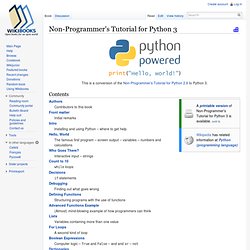
Interactive input – strings Count to 10 while loops Decisions if statements Debugging Finding out what goes wrong Defining Functions Structuring programs with the use of functions Advanced Functions Example (Almost) mind-blowing example of how programmers can think Lists Variables containing more than one value For Loops A second kind of loop Boolean Expressions Computer logic – True and False – and and or – not Dictionaries Variables containing key/value pairs Using Modules Extensions to the standard set of functionality More on Lists Using elements or parts of lists Revenge of the Strings More advanced text manipulations. S Python Class - Educational Materials.
Welcome to Google's Python Class -- this is a free class for people with a little bit of programming experience who want to learn Python.
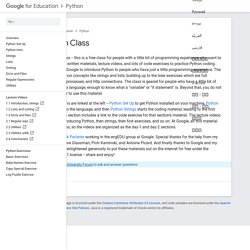
The class includes written materials, lecture videos, and lots of code exercises to practice Python coding. These materials are used within Google to introduce Python to people who have just a little programming experience. The first exercises work on basic Python concepts like strings and lists, building up to the later exercises which are full programs dealing with text files, processes, and http connections. The class is geared for people who have a little bit of programming experience in some language, enough to know what a "variable" or "if statement" is. Beyond that, you do not need to be an expert programmer to use this material. This material was created by Nick Parlante working in the engEDU group at Google. Hacking Secret Ciphers with Python.
“Hacking Secret Ciphers with Python” teaches complete beginners how to program in the Python programming language.

The reader not only learns about several classical ciphers, but also how to write programs that encrypt and hack these ciphers. The full source code is given and explained line-by-line for ciphers such as the Caesar cipher, transposition cipher, simple substitution cipher, multiplicative & affine ciphers, Vigenere cipher, and hacking programs for each of these ciphers.
The final chapters cover public key cryptography and the modern RSA cipher. 100% of the proceeds from this book are donated to the Electronic Frontier Foundation, the Creative Commons, and the Tor Project. This book is aimed at middle and high school students or adults. Download the .pdf version for free. Python & Cryptography Books I Recommend (if you don't mind paying) These books take a more conventional approach to covering programming concepts. Contact You can email the author at al@inventwithpython.com. Learn Python The Hard Way. Dive Into Python. 6.00 Introduction to Computer Science and Programming, Fall 2008. Python Programming. Python Programming From Wikibooks, open books for an open world Jump to: navigation, search This book describes Python, an open-source general-purpose interpreted programming language available for a broad range of operating systems.
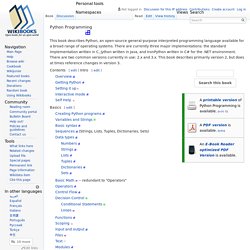
There are currently three major implementations: the standard implementation written in C, Jython written in Java, and IronPython written in C# for the .NET environment. The Python Tutorial. Python is an easy to learn, powerful programming language.

It has efficient high-level data structures and a simple but effective approach to object-oriented programming. Python’s elegant syntax and dynamic typing, together with its interpreted nature, make it an ideal language for scripting and rapid application development in many areas on most platforms. The Python interpreter and the extensive standard library are freely available in source or binary form for all major platforms from the Python Web site, and may be freely distributed. The same site also contains distributions of and pointers to many free third party Python modules, programs and tools, and additional documentation.
The Python interpreter is easily extended with new functions and data types implemented in C or C++ (or other languages callable from C). This tutorial introduces the reader informally to the basic concepts and features of the Python language and system. The Glossary is also worth going through. Www.greenteapress.com/thinkpython/thinkCSpy/thinkCSpy.pdf. PythonTurtle. Python Introduction - Google's Python Class - Google Code. Python is a dynamic, interpreted language.

Source code does not declare the types of variables or parameters or methods. This makes the code short and flexible, and you lose the compile-time type checking in the source code. Python tracks the types of all values at runtime and flags code that does not make sense as it runs. (todo: link here to the companion video segment for this section) Google Python Class Day 1 Part 1. Working with files and directories in Python. Online IDE & Debugging Tool >> C/C++, Java, PHP, Python, Perl and 40+ compilers and intepreters.
An Introduction to Interactive Programming in Python. About this course: This two-part course is designed to help students with very little or no computing background learn the basics of building simple interactive applications.

Our language of choice, Python, is an easy-to learn, high-level computer language that is used in many of the computational courses offered on Coursera. To make learning Python easy, we have developed a new browser-based programming environment that makes developing interactive applications in Python simple. These applications will involve windows whose contents are graphical and respond to buttons, the keyboard and the mouse. In part 1 of this course, we will introduce the basic elements of programming (such as expressions, conditionals, and functions) and then use these elements to create simple interactive applications such as a digital stopwatch. Part 1 of this class will culminate in building a version of the classic arcade game "Pong". Python In One Easy Lesson. Nick Parlante Nov 2010.
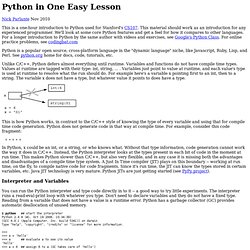
Hands-On Python A Tutorial Introduction for Beginners. Hands-On Python A Tutorial Introduction for Beginners Contents Chapter 1Beginning With Python 1.1.

Context. A Python Book: Beginning Python, Advanced Python, and Python Exercises. 2.2 Regular Expressions For more help on regular expressions, see: 2.2.1 Defining regular expressions A regular expression pattern is a sequence of characters that will match sequences of characters in a target.
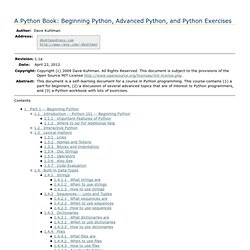
The patterns or regular expressions can be defined as follows: Literal characters must match exactly. Because of the use of backslashes in patterns, you are usually better off defining regular expressions with raw strings, e.g. r"abc". 2.2.2 Compiling regular expressions When a regular expression is to be used more than once, you should consider compiling it. Import sys, re pat = re.compile('aa[bc]*dd') while 1: line = raw_input('Enter a line ("q" to quit):') if line == 'q': break if pat.search(line): print 'matched:', line else: print 'no match:', line.